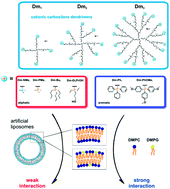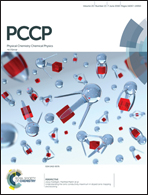Phosphonium carbosilane dendrimers – interaction with a simple biological membrane model
Abstract
The influence of three generations of five different phosphonium carbosilane dendrimers and one ammonium carbosilane dendrimer as a reference (PMe3, PBu3, P(Et2)2(CH2)3OH, PPh3, P(MeOPh)3 and NMe3, peripheral functional groups) on dimyristoylphosphatidylcholine (DMPC) or a lipid mixture dimyristoylphosphatidylcholine/dimyristoylphosphatidylglycerol (DMPC/DMPG) of liposomes was studied by fluorescence polarization measurements and differential scanning calorimetry. All types of dendrimers interacted with neutral as well as negatively charged liposomes, but the strength and observed influence were different. Concentration, type of peripheral functional group modification and dendrimer generation were the main factors influencing the interaction. Generally, weak interactions as well as destabilization of the lipid membranes at low concentrations, regardless of liposome type, were observed in the case of DmPMe3, DmNMe3, DmPBu3 and DmP(Et2)2(CH2)3OH. Dendrimers with PPh3 and P(MeOPh)3 peripheral functional groups interacted much more strongly and increased the rigidity of liposomes. Electrostatic interactions, the hydrophobicity of substituents and charge shielding on the peripheral phosphonium group are important factors in the interaction. We suggest that, among the other types of dendrimers, the dendrimer with the P(MeOPh)3 peripheral functional group is a highly promising candidate for the design of a drug delivery system due to its positive charge, efficient interaction with lipidic membranes and low cytotoxicity.



 Please wait while we load your content...
Please wait while we load your content...